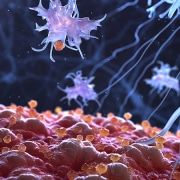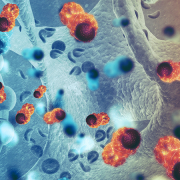Diabetes, the pancreas and the liver
We know that the liver and pancreas can contribute to diabetes, but how significant is their role and what part does genomics play?
A new study looking at the extent to which liver and pancreas fat content and volume can impact on diabetes risk has published its results. The research, funded by Diabetes UK, combined MRI scans and genomic data across a large cohort to explore the possibility of a genetic link.
Fatty liver disease
Non-alcoholic fatty liver disease (NAFLD) is caused when fat deposits build up in the liver. The early stages of the condition are typically mild and without symptoms, but it can progress to serious liver damage over time.
NAFLD is most common in people over 50 who are overweight, smoke or who have other conditions such as type 2 diabetes, high blood pressure or high cholesterol. It can also occur in younger people, including children, who do not have these risk factors, indicating that there is likely to be a genetic component as well.
Association with diabetes
It has been known for some time that type 2 diabetes is more common in people with NAFLD, but the causal relationship between the two conditions has been unclear.
Until this point, it has been difficult to say whether one condition makes someone more likely to have the other, or if other factors (for example, being overweight) increase the chances of both, so they are likely to occur together without one causing the other.
As well as the liver, fat can also accumulate in the pancreas, and this, too, is associated with increased risk of type 2 diabetes. This is unsurprising as the pancreas and liver are the two organs most closely associated with regulating blood sugar levels: the islet cells in the pancreas release hormones in response to blood sugar levels which signal to the liver to increase or decrease glucose production.
Finding connections
For the study, researchers used UK Biobank MRI scan data to look at the size and fat content of the liver and pancreas in 32,000 people.
The people’s genomes were then screened for gene variants associated with liver and pancreas volume and fat levels that were identified in a previous large genome-wide association study of people with diabetes.
This type of approach is called Mendelian randomisation: a method that allows researchers to use the known variation caused by genes to compare and tease out the causal relationships between factors that are otherwise difficult to differentiate from background noise in the data.
The results of the analysis showed a causal role for liver fat and pancreas size in type 2 diabetes. Liver size and pancreas fat levels, on the other hand, did not increase the risk of developing the condition.
The researchers emphasise that type 2 diabetes is a complex disease and that many factors can contribute to the risk of a person developing it. Their findings do contribute to the potential for personalised medicine, however. For example, lifestyle adjustments might be recommended for people who are genetically predisposed to NAFLD to reduce the risk of diabetes, or diabetes patients could be offered screening for NAFLD.
An overview of the study is available to read here
–









